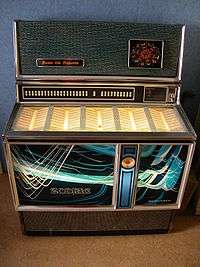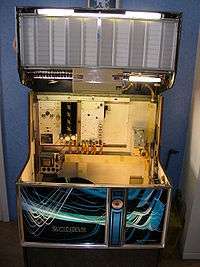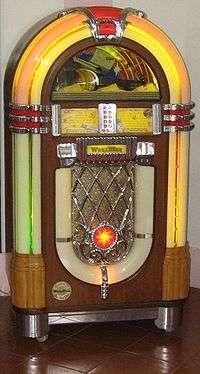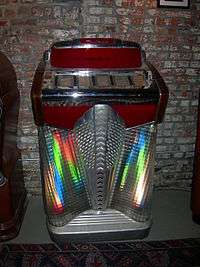Jukebox
A jukebox is a partially automated music-playing device, usually a coin-operated machine, that will play a patron's selection from self-contained media. The classic jukebox has buttons, with letters and numbers on them, which, when one of each group entered after each other, are used to select a specific record. Some may use Compact Discs instead. Disc changers are similar devices that are intended for home use, are small enough to fit in a shelf, may hold up to 400 discs, and allow discs to be easily removed, replaced, and inserted by the user.

(1971)


History
Coin-operated music boxes and player pianos were the first forms of automated coin-operated musical devices. These devices used paper rolls, metal disks, or metal cylinders to play a musical selection on an actual instrument, or on several actual instruments, enclosed within the device.
In the 1890s, these devices were joined by machines which used recordings instead of actual physical instruments.[1][2]
In 1890, Louis Glass and William S. Arnold invented the nickel-in-the-slot phonograph, the first of which was an Edison Class M Electric Phonograph retrofitted with a device patented under the name of Coin Actuated Attachment for Phonograph. The music was heard via one of four listening tubes.[3]
Early designs, upon receiving a coin, unlocked the mechanism, allowing the listener to turn a crank that simultaneously wound the spring motor and placed the reproducer's stylus in the starting groove.
Frequently, exhibitors would equip many of these machines with listening tubes (acoustic headphones) and array several of these machines in "phonograph parlors", allowing the patron to select between multiple records, each played on its own machine.
Some machines even contained carousels and other mechanisms for playing multiple records. Most machines were capable of holding only one musical selection, the automation coming from the ability to play that one selection at will.
In 1918, Hobart C. Niblack patented an apparatus that automatically changed records, leading to one of the first selective jukeboxes being introduced in 1927 by the Automated Musical Instrument Company, later known as AMI.
In 1928, Justus P. Seeburg, who was manufacturing player pianos, combined an electrostatic loudspeaker with a record player that was coin-operated.[4] This Audiophone machine was wide and bulky because it had eight separate turntables mounted on a rotating Ferris wheel-like device, allowing patrons to select from eight different records.
Later versions of the jukebox included Seeburg's Selectophone with 10 turntables mounted vertically on a spindle. By maneuvering the tone arm up and down, the customer could select from 10 different records.[3]
Many manufacturers produced jukeboxes, including: 1890s Wurlitzer, late 1920s Seeburg, 1930s "Rock-Ola" (whose name is actually based on that of the company founder, David Cullen Rockola), Sound Leisure, and Crosley.
Greater levels of automation were gradually introduced. As electrical recording and amplification improved there was increased demand for coin-operated phonographs.
The word "jukebox" came into use in the United States beginning in 1940, apparently derived from the familiar usage "juke joint", derived from the Gullah word "juke" or "joog", meaning disorderly, rowdy, or wicked.[5] As it applies to the 'use of a jukebox', the terms juking (verb) and juker (noun) are the correct expressions.
Styling progressed from the plain wooden boxes in the early thirties to beautiful light shows with marbleized plastic and color animation in the Wurlitzer 850 Peacock of 1941. But after the United States entered the war, metal and plastic were needed for the war effort. Jukeboxes were considered "nonessential", and none were produced until 1946. The 1942 Wurlitzer 950 featured wooden coin chutes to save on metal. At the end of the war, in 1946, jukebox production resumed and several "new" companies joined the fray. Jukeboxes started to offer visual attractions: bubbles, waves, and circles of changing color which came on when a sound was played.
Song-popularity counters told the owner of the machine the number of times each record was played (A and B side were generally not distinguished), with the result that popular records remained, while lesser-played songs could be replaced.

Wallboxes were an important, and profitable, part of any jukebox installation. Serving as a remote control, they enabled patrons to select tunes from their table or booth. One example is the Seeburg 3W1, introduced in 1949 as companion to the 100-selection Model M100A jukebox. Stereo sound became popular in the early 1960s, and wallboxes of the era were designed with built-in speakers to provide patrons a sample of this latest technology.
Initially, jukeboxes playing recorded music were playing music recorded on wax cylinders. In the early part of the 20th century, the shellac 78 rpm record dominated jukeboxes.
In 1950, the Seeburg Corporation introduced an all 45 rpm vinyl record jukebox. Since the 45s were smaller and lighter, they soon became the dominant jukebox media for the last half of the 20th century.
33⅓ RPM, CDs, and videos on DVDs were all introduced and used in the last decades of the century. MP3 downloads, and Internet-connected media players came in at the start of the 21st century.
The jukebox's history has followed the wave of technological improvements in music reproduction and distribution. With its large speaker size, facilitating low-frequency (rhythm) reproduction, and large amplifier, the jukebox played sound with higher quality and volume than the listener could in his or her home, sometimes music with a "beat" (strong bass, made possible by the large speakers).
While often associated with early rock and roll music (which by at least one source is said to have begun in the mid 1940s), the popularity of jukeboxes extends back much earlier, including classical music, opera and the swing music era (originating in the 1930s).
Jukeboxes were most popular from the 1940s through the mid-1960s, particularly during the 1950s. By the middle of the 1940s, three-quarters of the records produced in America went into jukeboxes.[6] Billboard published a record chart measuring jukebox play during the 1950s, which briefly became a component of the Hot 100; by 1959, the jukebox's popularity had waned to the point where Billboard ceased publishing the chart and stopped collecting jukebox play data.[7]
In 1977, The Kinks recorded a song called "Juke Box Music" for their album Sleepwalker.
Models designed and produced in the late 20th century needed more panel space for the increased number of record titles they needed to present for selection, reducing the space available for decoration, leading to less ornate styling in favor of functionality and less maintenance.
Two companies still manufacture classically styled jukeboxes: Rockola, based in California, and Sound Leisure, based in Leeds in the UK. Both companies manufacture jukeboxes based on a CD playing mechanism. However, in April 2016, Sound Leisure showed a prototype of a "Vinyl Rocket" at the UK Classic Car Show. It stated that it would start production of the 140 7" vinyl selector (70 records) in summer of the same year.[8][9]
Notable models


(1948)

(1949)
- 1927 LINK – valued at US$40,000 and extremely rare[3]
- 1933 Wurlitzer Debutante (the first jukebox from Wurlitzer?)
- 1940 Gabel Kuro – 78 rpm, the last model of this manufacturer, four or five are known to exist and are valued at US$125,000[3]
- 1942 Rock-Ola President – only one known to exist and valued at least US$150,000[3]
- 1942 Rock-Ola Premier – 15 known to exist and valued at US$20,000[3]
- 1942 Wurlitzer 950 – 75–90 known to exist and valued at US$35,000[3]
- 1946 Wurlitzer Model 1015[10] – referred to as the "1015 bubbler" offered 24 selections. More than 56,000 were sold in less than two years and it is considered a pop culture icon. Designed by Wurlitzer's Paul Fuller.[3]
- 1947 Rock-Ola 1422 – This was the exterior used for the credit sequences for season 11 of the sitcom Happy Days.
- 1948 Filben FP-300 Maestro, 78 rpm
- 1949 Seeburg Select-o-matic
- 1952 Seeburg M100C – This was the jukebox exterior used in the credit sequences for Happy Days in seasons 1–10. It played up to fifty 45 rpm records making it a 100-play. It was a very colorful jukebox with chrome glass tubes on the front, mirrors in the display, and rotating animation in the pilasters.[3]
- 1967 Rock-Ola 434 Concerto – This was the jukebox interior used in the credit sequence for the 11th and final season of Happy Days. Like the Seeburg M100C, it played up to fifty 45 rpm records, but featured a horizontal playback mechanism unlike the M100C.[3]
Decline
Traditional jukeboxes once were an important source of income for record publishers. Jukeboxes received the newest recordings first. They became an important market-testing device for new music, since they tallied the number of plays for each title. They offered a means for the listener to control the music outside of their home, before audio technology became portable. They played music on demand without commercials. They also offered the opportunity for high fidelity listening before home high fidelity equipment became affordable.[3]
The invention of the portable radio in the 1950s and the portable cassette tape deck in the 1960s were key factors in the decline of the jukebox. They enabled people to have their own selection of music with them, wherever they were. Jukeboxes became a dying industry during the 1970s, before being revived somewhat by compact disc jukeboxes during the 1980s and 1990s, followed by digital jukeboxes using the MP3 format. The greater selection and track length flexibility of digital jukeboxes offered more for the listener, with lower space requirements and operating costs making jukeboxes more attractive to establishment owners. While jukeboxes maintain popularity in bars, they have fallen out of favor with what were once their more lucrative locations—restaurants, diners, military barracks, video arcades, and laundromats.
In 1995, the United States Postal Service issued a 25 cent stamp commemorating the phonograph jukebox.[11]
Digital jukebox and apps
While the number of traditional jukeboxes has declined, digital jukeboxes, also called "social jukebox", have been introduced.[12]
Most of the digital jukebox services provide apps to request songs and use further features. Most are focused at the end-user and provide the guests of private events with the ability to collectively control the music.
Aiming at public venues, TouchTunes comes with a device most similar to a classic Jukebox, including a touch display to choose music and payment options.
Other services provide both the functionality to control the music at a public venue, to set up a private jukebox or provide wishlists to DJs and radio stations.
See also
References
- Athitakis, Mark (1 December 1999). "Riff Raff: Jukebox hero and Gordon Dorsey". SF Weekly.
- Great Geek Manual – Glass/Arnold patents
- Weiss, Brett (15 October 2010). "Rock on with vintage jukeboxes". Antique Week.
- Carlisle, Rodney (2004). Scientific American Inventions and Discoveries. Hoboken, NJ: Wiley. ISBN 0-471-24410-4.
- "Juke house". Dictionary.com.
- Cowen, Tyler (2000). In Praise of Commercial Culture. Harvard University Press. pp. 164, 166. ISBN 0-674-00188-5.
- Molanphy, Chris (1 August 2013). "How The Hot 100 Became America's Hit Barometer". All Things Considered. NPR. Retrieved 14 March 2018.
- Miller, Norman (11 May 2016). "Why fans of vintage vinyl love this brand-new machine". BBC Capital.
- "Classic Jukeboxes". SoundLeisure.
- "Wurlitzer 1015". Picollecta. Archived from the original on 14 January 2015. Retrieved 14 January 2015.
- "Stamp Series". United States Postal Service. Archived from the original on 2013-08-10. Retrieved Sep 2, 2013.
- France, Jasmine. "Create jukebox playlists before hitting the town". cnet. Retrieved 3 August 2016.
External links
